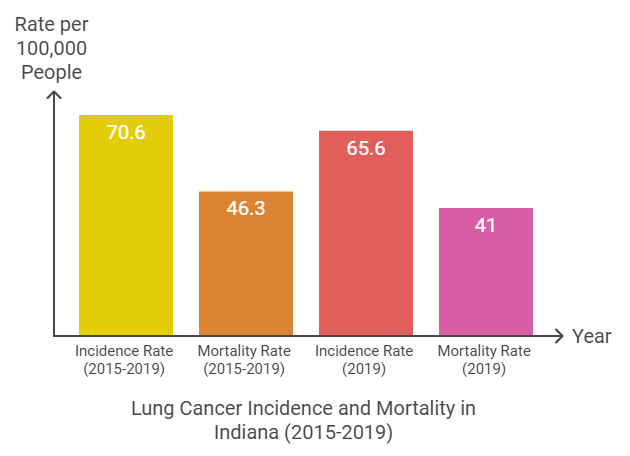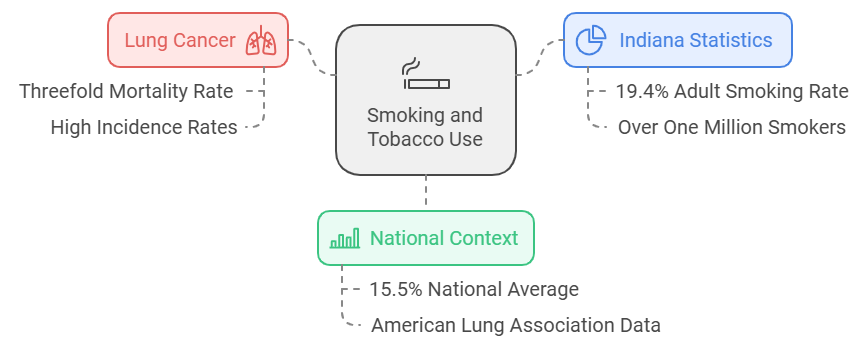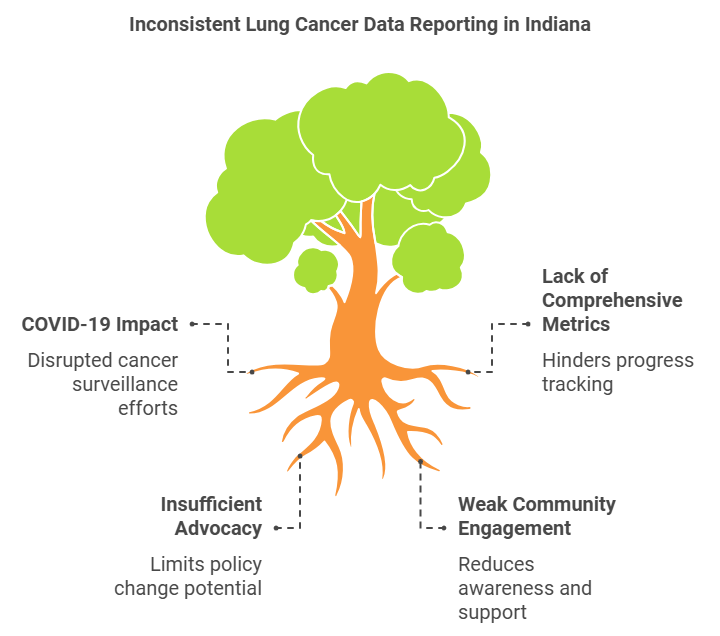Lung cancer remains a significant public health issue in Indiana, as well as across the United States. It is not a singular disease but a collection of cancers that originate in the lungs and surrounding tissues.
The primary types of lung cancer include small cell lung cancer (SCLC), non-small cell lung cancer (NSCLC), and lung carcinoid tumors.
In 2019 alone, 3,538 people lost their lives to this disease. Compounding the problem, Indiana’s adult smoking rate was 19.4% in 2020—well above the national average—placing over one million Hoosiers at increased risk.
Incidence and Mortality

Lung cancer poses a heavy burden in Indiana. From 2015 to 2019, the state averaged 5,732 new cases annually, with an incidence rate of 70.6 per 100,000 people.
In 2019 alone, 5,586 cases were diagnosed, translating to an age-adjusted rate of 65.6 per 100,000. Mortality rates, a critical indicator of disease severity, remain concerning according to some government sources.
Burden of Lung Cancer in Indiana (2015–2019)
Measure
Average Number of Cases/Deaths per Year
Rate per 100,000 (2015–2019)
Number of Cases/Deaths (2019)
Rate per 100,000 (2019)
Incidence
5,732
70.6
5,586
65.6
Mortality
3,726
46.3
3,538
41.9
Key Risk Factors and Contributing Causes
Smoking and Tobacco Use

Smoking remains the leading cause of lung cancer, with smokers facing a threefold higher mortality rate than non-smokers.
Indiana’s adult smoking rate stood at 19.4% in 2020, significantly above the national average of 15.5% according to the American Lung Association.
Radon Exposure
Radon gas, the second leading cause of lung cancer nationwide, is another critical concern in Indiana.
Policies surrounding radon testing and mitigation remain insufficient, particularly in real estate transactions, homes, and schools.
Strengthening these measures could play a crucial role in reducing incidence.
Secondhand Smoke
Secondhand smoke exposure is responsible for approximately 7,330 lung cancer deaths annually in the United States according to National Cancer Institute.
Indiana must address this preventable cause of lung cancer through public health initiatives and stricter regulations on smoking in public spaces.
Disparities in Lung Cancer Outcomes
Lung cancer incidence and mortality rates exhibit significant disparities by gender, race, and socioeconomic status in Indiana.
Moreover, black males experienced higher mortality rates than white males, underscoring the role of structural inequities in healthcare access, early diagnosis, and treatment.
Another serious issue tied to lung health is mesothelioma, a rare cancer caused by asbestos exposure.
While it’s distinct from lung cancer, the toll it takes on families is just as devastating.
Many families affected by mesothelioma turn to legal settlements for support, as these cases often lead to average settlements for mesothelioma deaths.
Stage of Diagnosis
Early detection dramatically improves survival rates for lung cancer.
However, during 2015–2019, a substantial proportion of lung cancer cases in Indiana were diagnosed at advanced stages, limiting treatment options and reducing survival chances.
Increasing access to screening and public awareness about early symptoms could help reverse this trend.
Screening and Prevention
Screening Rates in Indiana
Lung cancer screening with low-dose computed tomography (LDCT) is a vital tool for early detection, especially for high-risk individuals.
According to the 2023 “State of Lung Cancer” (SOLC) report, Indiana ranked 24th in the nation for lung cancer screenings, with only 5.1% of eligible individuals undergoing annual LDCT scans.
This rate is marginally higher than the national average of 4.5% but still reflects a gap in screening outreach and access.
Impact of Screening
Screening high-risk populations can reduce lung cancer mortality by up to 20% according to NCBI study.
Increasing screening rates is therefore a critical goal for reducing the burden of lung cancer in Indiana.
Policy Recommendations
Addressing Tobacco Use
Raising Indiana’s cigarette tax has been identified as an effective measure to deter youth from smoking and to encourage current smokers to quit.
Radon Mitigation
Implementing stronger policies for radon testing and mitigation in homes, schools, and real estate transactions would address this significant but preventable cause of lung cancer.
Public Awareness and Education
Efforts to increase public awareness about lung cancer risk factors, symptoms, and the importance of screening can empower individuals to take proactive steps toward prevention and early detection.
Survival Rates and Treatment Advances
National Trends in Survival
The five-year lung cancer survival rate has improved by 17% for people of color nationally in the last two years.
This encouraging trend reflects advancements in medical research, access to healthcare, and early diagnosis.
However, disparities persist, and further efforts are needed to ensure equitable healthcare access for all populations.
Indiana’s Challenges

Indiana has not consistently reported comprehensive data for some key lung cancer metrics, partly due to the impact of COVID-19 on cancer surveillance.
This lack of data hampers efforts to track progress and identify areas for improvement.
Increasing Access to Lung Cancer Screening Act, can drive meaningful policy changes.
Community engagement through organizations like the Indiana Cancer Consortium (ICC) offers additional avenues for collaboration and progress.
Conclusion
Lung cancer continues to exact a heavy toll on Indiana residents, with high incidence and mortality rates driven by smoking, radon exposure, and disparities in healthcare access.
While progress has been made nationally in survival rates and awareness, Indiana lags in critical areas such as screening and radon policy.
By addressing these gaps through targeted interventions and policy changes, Indiana can reduce the burden of lung cancer and improve outcomes for its residents.
As the state looks to the future, a comprehensive, collaborative approach will be essential to ending the devastating impact of lung cancer.










